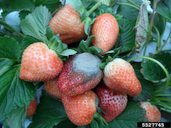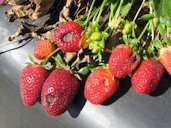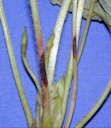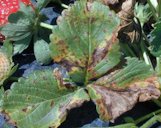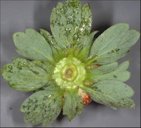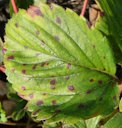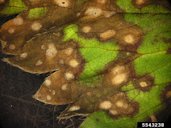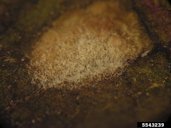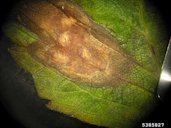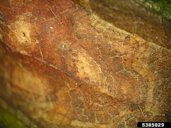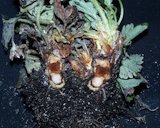| Strawberry Diseases | ||||||||||||||||||||||||||||||||||||||||||||
|---|---|---|---|---|---|---|---|---|---|---|---|---|---|---|---|---|---|---|---|---|---|---|---|---|---|---|---|---|---|---|---|---|---|---|---|---|---|---|---|---|---|---|---|---|
| Back
to Strawberry Page 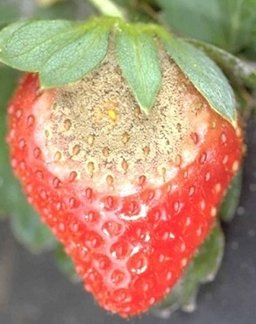 Fig. 1 Botrytis fruit rot 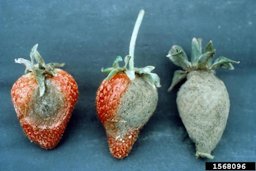 Fig. 2  Gray mold (Botrytis cinerea) 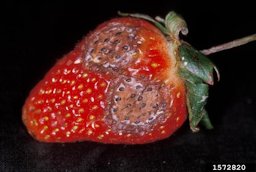 Fig. 5  Anthracnose (C. acutatum) fruit 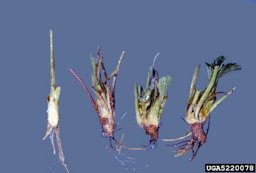 Fig. 8  Anthracnose (C. fragariae)  Fig. 9  Root necrosis symptoms (few functional roots) 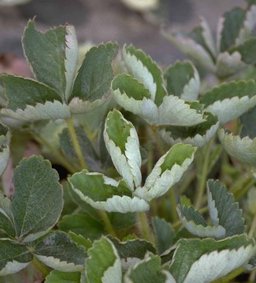 Fig. 13  Powdery mildew caused by Podosphaera aphanis 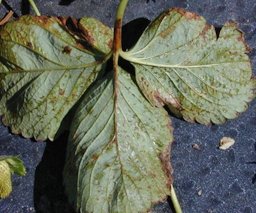 Fig. 14  Water-soaked lesions of angular leaf spot  Fig. 18  Mycosphaerella fragariae (leaf spot) 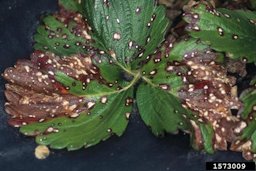 Fig. 19  Severe infection of strawberry by leaf spot 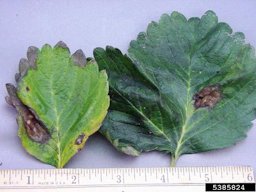 Fig. 23  Phomopsis leaf blight (Phomopsis obscurans) on strawberry 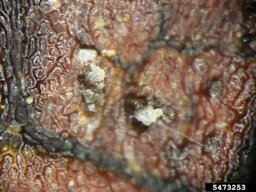 Fig. 24  Leaf scorch (Diplocarpon earlianum) 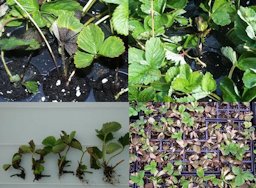 Fig. 27  Range of symptoms caused by Phytophthora cactorum in plug production facilities. Leaf petioles and leaf tissues turn black (top); plants remain stunted and do not form roots (bottom left showing severely diseased to healthy plugs) and plants. 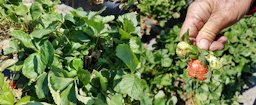 Fig. 29  Aphelenchoides besseyi symptoms on strawberry. Left: twisting, crinkling and curling of strawberry leaves; right: abnormally shaped “broccoli” fruit. Plant City, FL, 2016–17 season.  Fig. 30  Strawberry plant wilting and collapsing due to charcoal rot
| Plant pathogens attack virtually all strawberry plant parts resulting in
direct yield loss as well as loss due to quality factors. Infection of
fruit by one pathogen may lead to infection or colonization by other
pathogens, confounding the situation. Major disease problems on Florida
strawberry fruit are botrytis (gray mold) and colletotrichum diseases,
while powdery mildew, angular leaf spot, common leaf spot, leaf blight,
and leaf scorch are primarily strawberry leaf diseases. 1 Botrytis Fruit Rot (gray mold) Botrytis cinerea Botrytis fruit rot (BFR), also known as gray mold, is caused by the fungus Botrytis cinerea and is one of the most important diseases of strawberry in Florida and worldwide. The fungus infects all aerial parts of the plant; however, most economic damage occurs when flowers and fruit are affected, occasionally resulting in yield losses greater than 50%. BFR is also a post-harvest disease, because infections that begin in the field continue to develop during storage and transit at refrigeration temperatures. 7 symptoms are usually observed 2 to 4 weeks after infection, on green and ripening fruit. Lesions typically develop under the calyx as small, light brown spots that enlarge quickly and invade the rest of the fruit. Lesions become fully covered with dark mycelium bearing many gray spores (conidia). Large numbers of spores are released as visible gray puffs when infected fruit are disturbed. Eventually, the fruit becomes totally covered and mummified. 7 BFR should be managed by cultural and chemical methods. There are no commercial cultivars highly resistant to this disease. Removal of diseased fruit from under the plant canopy reduces inoculum and, consequently, infection efficiency and disease spread by fruit-to-fruit contact. 7
Fig. 3. A strawberry rachis completely engulfed by a gray mold fungus, B. cinerea Fig. 4. Gray mold (B. cinerea)
Further Reading Botrytis Fruit Rot or Gray Mold of Strawberry, University of Florida pdf Colletotrichum Diseases C. acutatum, C. fragariae, C. gloeosporioides Anthracnose fruit rot and root rot Currently, the most important diseases are anthracnose fruit rot and root rot caused by C. acutatum. Anthracnose root rot causes problems during the plant establishment period in October and causes a blackening of the roots that can reduce the vigor of plants and, when severe, causes the plant to wilt and die. Anthracnose fruit rot epidemics can force growers to abandon production fields. The disease develops on young fruit and produces sunken, dark lesions on the fruit making them unmarketable. In severe epidemics, the pathogen also causes a flower blight and can produce sunken lesions on leaf petioles. 1
Fig. 6. Anthracnose (C. acutatum) Fig. 7. Anthracnose fruit rot
Crown rot Colletotrichum crown rot can also be an important disease and is primarily caused by C. gloeosporioides but also C. fragariae. The crowns of infected plants become necrotic and cause the sudden wilt and death of apparently healthy plants when temperatures are warm in the fall or spring. Treasure cultivar is considered highly resistant to crown rot. Sweet Charlie, Carmine, and Camino Real have moderate levels of resistance, and Festival and Camarosa are highly susceptible. 1 Root Necrosis C. acutatum is widely known as a fruit rot pathogen, but also infects other strawberry organs, including the roots. Root necrosis has been observed in Florida since 2000.
Fig. 10. Root necrosis symptoms (root lesions) Fig. 11. Stunted plants due to root necrosis Fig. 12. Petiole lesions caused by C. acutatum Diseases caused by C. acutatum are best controlled by exclusion (not introducing the pathogen into the field). Therefore, transplants should be purchased from a reputable source. However, this does not guarantee disease-free material. For that reason, transplants should be inspected for petiole lesions caused by C. acutatum (Fig. 12). 3 'Sweet Charlie' is considered relatively resistant to anthracnose fruit rot whereas 'Strawberry Festival' is moderately susceptible. Newer cultivars 'Florida Radiance' and 'Sensation' (FL 127) are more resistant than 'Strawberry Festival'. 2 Further Reading Anthracnose Fruit Rot of Strawberry, University of Florida pdf Root Necrosis of Strawberry Caused by Colletotrichum acutatum, University of Florida pdf Powdery Mildew Podosphaera aphanis (syn. Sphaerotheca macularis) Once infected with powdery mildew, strawberry leaf edges begin to roll upward, and a sparse white growth of conidia and conidiophores may be seen on the under surface of the leaves. If infection is severe, leaves may show purple blotches or they may be killed. In Central Florida, the disease is typically most severe in November and December, and it may reappear in late February and March. 1 Cultivars differ widely in their resistance to powdery mildew. ‘Strawberry Festival’ and ‘FL Radiance’ are moderately susceptible and the new cultivar ‘Sensation’ (FL 127) is highly susceptible. 2 Rain, dew, and overhead irrigation inhibit the fungus. Because dry conditions and high humidity are common in greenhouses and plastic tunnels, powdery mildew typically is more severe in protected culture. 2 Disease-free transplants should be used for controlling powdery mildew, although fields can become infected by conidia blown in from neighboring fields. 2 Angular Leaf Spot Xanthomonas fragariae This disease favors cool, wet weather and can become severe when overhead irrigation is used for freeze protection. The first signs of angular leaf spot are dark green water lesions on the under surfaces of the leaves. These later become visible on the upper surfaces as reddish or brownish angular spots of variable size. The most notable sign is the occurrence of whitish, slimy droplets of bacterial exudate on the under surface of the leaflets during cool weather. When the droplets dry, a thin, clear scaly film or clear raised bumps appear. The leaf under surfaces may also appear as if coated with clear lacquer at this point. The disease diminishes upon the onset of warmer weather. 1 The best way to control ALS is to use pathogen-free transplants. Since this is not always possible, the use of overhead sprinklers during plant establishment and for freeze protection should be minimized to reduce the spread of the disease. 4 Copper-based products can provide effective control of the disease in some instances, but low rates of copper should be used since phytotoxicity (reddening of older leaves, slow plant growth, and yield decrease) has been documented with repeated sprays. 4 For chemical control, see the publication below.
Fig. 15. Reddish-brown spots of angular leaf spot Fig. 16. Translucent spots of angular leaf spot Fig. 17. Water-soaked lesions of angular leaf spot on the calyx Further Reading Angular Leaf Spot of Strawberries, University of Florida pdf Leaf Spot Mycosphaerella fragariae Spots are small, purplish-red lesions less than 0.1 in. (3 mm) in diameter. The final lesion size depends on the variety. On certain varieties, the lesions remain very small and numerous, and leaflets appear "rusty." On others, the lesions increase in size to 0.2 in. (6 mm) or larger and develop white or gray centers with reddish-purple to dark purple borders. Severe infection can result in death of leaflets and defoliation of plants. 1
Fig. 20. M. fragariae Fig. 21. Strawberry leaf spot (M. fragariae), leaf spot lesions with conidia Fig. 22. Leaf spot lesions with conidia Leaf Spot Diseases of Strawberry, University of Florida pdf Leaf Blight/Fruit Rot Phomopsis obscurans Phomopsis leaf blight and fruit rot can be a serious problem on plants produced in the Southeastern U.S. The initial infection spots of this fungus are larger than leaf spot. From one to five lesions may occur on a leaf. The lesions are circular and reddish-purple at first. Mature lesions are zonate and dark brown in color, with a light brown to tan periphery ringed by a purple zone. The spots are frequently V-shaped with the widest part of the lesions at the leaf margin and the narrow base centered on a vein. Black specks (pycnidia) dot the central area of the older lesions. 1 This fungus also affects fruit. Initial lesions appear as round, light pink, water-soaked areas on the surface. Lesions may coalesce. Infected areas turn brown, and the entire fruit ultimately becomes infected. 1
Fig. 24. Phomopsis leaf blight and fruit rot (P. obscurans), a single, brown, blighted area of a leaf Fig. 25. Close-up of brown, blighted area with small, round, darker brown spore-producing bodies ("pycnidia") Leaf Scorch Marssonina fragariae/Diplocarpon earliana This fungus produces numerous purplish blotches of irregular shape and small size. Clusters of the blotches turn brown but never white or gray as in the case of leaf spot. Dark glistening acervuli appear in the lesions on the upper surfaces of the leaves. In severe cases, the leaf margins curl upward, and the leaves progressively dry to a tan color from the margins to the midrib. 1 Charcoal Rot Macrophomina phaseolina Charcoal rot is caused by Macrophomina phaseolina and has become more prevalent in Florida strawberry fields since methyl bromide was phased out. The fungus produces resistant long-lived structures called sclerotia that survive in the soil and on strawberry debris. These microsclerotia are usually the primary source of new infections. Their numbers increase in the soil when susceptible hosts are grown continuously for several seasons. Plants initially show signs of water stress and eventually collapse (Fig. 31). Cutting the crowns of affected plants reveals reddish-brown necrotic areas along the margins and in the woody vascular ring. 6 Management of M. phaseolina involves a combination of cultural practices and chemical methods. Consult the publication for information.
Fig. 31. Internal symptoms of charcoal rot, including reddish-brown necrotic areas on the margins and woody vascular ring of the crown Further Reading Charcoal Rot of Strawberries Caused by Macrophomina phaseolina, University of Florida pdf Phytophthora Crown Rot Phytophthora cactorum and P. citricola Phytophthora crown rot can be a serious disease of annual production strawberry in Central Florida. The disease is characterized by a sudden decline and wilt of plants. Reddish-brown coloration on the internal crown makes symptoms difficult to distinguish from those produced by Colletotrichum gloeosporioides or C. fragariae. Infected transplants are the primary source of inoculum for epidemics in Florida. The pathogen produces zoospores that infect strawberry plants under wet conditions. Phytophthora species produce oospores that may persist in infested soil and plant debris; however, oospores have not been observed in Florida. The disease favors warm temperatures and prolonged periods of wetness, conditions that are common during the plant establishment period (October) in Florida. 1
Fig. 28. Internal crown discoloration due to P. cactorum infection Further Reading Phytophthora Crown Rot of Strawberry, University of Florida pdf Foliar or Bud Nematodes Aphelenchoides spp. Foliar or bud nematodes (Aphelenchoides spp.) were until recently largely unknown to strawberry growers in Florida, and very little is known about their biology and behavior in the state. When present, foliar nematodes are capable of causing significant crop loss in strawberries. 5 Foliar nematodes can be disseminated in many ways. Infestation is most easily accomplished by rain or irrigation water washing the nematodes into the plant buds. Water is a major factor in helping the spread of foliar nematodes in a field because a thin film of water must be present for foliar nematodes to move across leaves and stems. 5 There are no good management practices for heavy infestations. The key is to implement management strategies preventatively or upon early detection of nematodes. The following is an overview of the different management options for foliar nematodes. Nematode-free plant material: production of disease-free nursery plants is the first and most important tactic to manage foliar nematodes. Hygiene and soil-free propagation techniques—growing plants in soilless media or pasteurizing media—can greatly reduce the occurrence of foliar nematodes. Discard infected plants: employ good sanitation practices by removing plant debris, promptly disposing of all infested plants, and eliminating weeds that can host foliar nematodes from around growing areas. Eliminate or limit overhead watering. Hot water treatment: Brooks reported in 1930 that nematodes suspended in water were killed by a temperature of 120°F (48°C) for 20 minutes or 47°C for 30 minutes and crimped plants in pots immersed in water 120°F (48°C) for 20 minutes resumed normal growth afterwards. 5 Further Reading Foliar or Bud Nematodes in Florida Strawberries, University of Florida pdf General Controls for diseases Nonchemical Nonchemical control strategies include planting certified plants, using resistant varieties, crop rotation, irrigation management, sanitation/destruction, and the use of plastic mulch. However, their use alone or in the absence of fungicides would result in severe losses. Nonchemical methods must be considered as tools that, in the presence of all other factors at a given time, add effectiveness to the overall disease management program. Growers may plant multiple varieties of strawberries to reduce the risks posed by various diseases and pests and also take advantage of market conditions. There is effort placed in producing disease resistant varieties; however, there are currently no major marketable varieties available with high levels of resistance to multiple pathogens. Certain varieties show select disease resistance, but no single variety has all the necessary characteristics for season-long productivity. 1 For chemical control, see Strawberry Production in the Vegetable Production Handbook of Florida, University of Florida pdf Further Reading Common Strawberry Diseases in Florida, University of Florida pdf 2015 Florida Plant Disease Management Guide: Strawberry, University of Florida pdf (archived) Florida Strawberry Producers' Experiences with Anthracose and Botrytis Fruit Rot, and Producers' Use of the Strawberry Advisory System, University of Florida pdf The Strawberry Advisory System: A Web-Based Decision Support Tool for Timing Fungicide Applications in Strawberry, University of Florida pdf | |||||||||||||||||||||||||||||||||||||||||||
| Bibliography 1 Mossler, Mark A. "Florida Crop/Pest Management Profiles: Strawberry." Agronomy Dept., UF/IFAS Extension, CIR1239, Original Pub. Dec. 2000, Revised Apr. 2003, Jan. 2004, July 2010, and Sept. 2012, Reviewed Dec. 2015, AskIFAS, Archived, edis.ifas.ufl.edu/pi037. Accessed 13 Nov. 2017, 18 Sept. 2019. 2 Peres, Natalia A. "2015 Florida Plant Disease Management Guide: Strawberry." Dept. of Plant Pathology, UF/IFAS Extension, PDMG-V3-50, Revised Mar. 2011, Revised Feb. 2015, Archived, AskIFAS, edis.ifas.ufl.edu/pg056. Accessed 22 Nov. 2017, 18 Sept. 2019. 3 Mertely, J. C. et al. "Root Necrosis of Strawberry Caused by Colletotrichum acutatum." Plant Pathology Dept., UF/IFAS Extension, PP-211, Original pub. Aug, 2005, Revised Jan. 2009, Sept. 2012, Aug. 2017, and Feb. 2022, AskIFAS, edis.ifas.ufl.edu/pp128. Accessed 24 Nov. 2017, 6 Jan. 2024. 4 Peres, Natalia A. "Angular leaf Spot of Strawberry." Plant Pathology Dept., UF/IFAS Extension, PP-199, Original pub. June 2004, Revised Apr. 2011, Dec. 2014, Aug. 2017 and Feb. 2022, AskIFAS, edis.ifas.ufl.edu/pp120. Accessed 24 Nov. 2017, 18 Sept. 2019, 6 Jan. 2024. 5 Dessaeger, J. and J. Noling. "Foliar or Bud Nematodes in Florida Strawberries." Entomology and Nematology Dept., UF/IFAS Extension, ENY-068, Original pub. Nov. 2017, Revised July 2021, AskIFAS, edis.ifas.ufl.edu/in1184. Accessed 25 Dec. 2017, 6 Jan. 2024. 6 Peres, N. A. et al. "Charcoal Rot of Strawberries Caused by Macrophomina phaseolina." Plant Pathology Dept., UF/IFAS Extension, PP242, Original pub. Oct. 2007, Revised Feb. 2018, and Feb. 2022, AskIFAS, edis.ifas.ufl.edu/pp161. Accessed 25 Mar. 2018, 6 Jan. 2024. 7 Peres, N.A. et al. "Botrytis Fruit Rot or Gray Mold of Strawberry." Plant Pathology Dept., UF/IFAS Extension, PP230, Original pub. July 2006, Revised Feb. 2018, and Feb. 2022, AskIFAS, edis.ifas.ufl.edu/pp152. Accessed 25 Mar. 2018, 6 Jan. 2024. Videos v1 Dowling, Madeline. "Strawberry Gray Mold: An Animated Disease Cycle." Clemson University, 2018, phytographics.com, (CC BY-NC 4.0 US), phytographics.com/. Accessed 18 Oct. 2019. v2 Dowling, Madeline. "Strawberry Gray Mold timelapse." 2018, Clemson University, phytographics.com, (CC BY-NC 4.0 US), phytographics.com/. Accessed 18 Oct. 2019. v3 Dowling, Madeline. "Anthracnose on Strawberry Disease Cycle." Clemson University, 2018, phytographics.com, (CC BY-NC 4.0 US), phytographics.com/. Accessed 18 Oct. 2019. v4 Dowling, Madeline. "Anthracnose on Strawberry Timelapse." Clemson University, 2018, phytographics.com, (CC BY-NC 4.0 US), phytographics.com/. Accessed 18 Oct. 2019. Photographs Fig. 1 "Botrytis Fruit Rot." Plant Pathology Dept., UF/IFAS Extension, AskIFAS, edis.ifas.ufl.edu/pp152. Accessed 22 Nov. 2017. Fig. 2 Sikora, Edward. "Gray mold (Botrytis cinerea) Pers.:Fr." Auburn University, Uploaded Jan. 19, 2013, Updated Aug. 21, 2012, Bugwood.org, (CC BY-NC 3.0 US), www.insectimages.org/browse/detail.cfm?imgnum=1568096. Accessed 22 Nov. 2017. Fig. 3 Bauer, Scott. "A strawberry rachis completely engulfed by a gray mold fungus, Botrytis cinerea." USDA Agricultural Research Service, Uploaded Mar. 4, 2003, Updated Dec. 11, 2006, Bugwood.org, (CC BY 3.0 US), www.insectimages.org/browse/detail.cfm?imgnum=1317024. Accessed 22 Nov. 2017. Fig. 4 Hamann, Jonas Janner. "Gray mold (Botrytis cinerea) Pers.:Fr." Universidade Federal de Santa Maria (UFSM), Uploaded Feb. 14, 2015, Updated Sept. 8, 2016, Bugwood.org, (CC BY 3.0 US), www.insectimages.org/browse/detail.cfm?imgnum=5527745. Accessed 22 Nov. 2017. Fig. 5 Holmes, Gerald. "Anthracnose (Colletotrichum acutatum) fruit." Strawberry Center, Cal Poly San Luis Obispo, Uploaded August 19, 2009, Updated March 12, 2017, Bugwood.org, (CC BY-NC 3.0 US), www.insectimages.org/browse/detail.cfm?imgnum=1572820. Accessed 22 Nov. 2017. Fig. 6 "Anthracnose (Colletotrichum acutatum) J. H. Simmonds." European and Mediterranean Plant Protection Organization Image Archive, Uploaded June 22, 2004, Updated Oct.10, 2017, Bugwood.org, (CC BY-NC 3.0 US), www.insectimages.org/browse/detail.cfm?imgnum=1263079. Accessed 22 Nov. 2017. Fig. 7 "Anthracnose fruit rot." Dept. of Plant Pathology, UF/IFAS Extension, AskIFAS, edis.ifas.ufl.edu/pg056. Accessed 22 Nov. 2017. Fig. 8 "Anthracnose (Colletotrichum fragariae) A.N. Brooks." Florida Division of Plant Industry, Uploaded July 9, 2007, Updated Aug. 6, 2007, Bugwood.org, (CC BY-NC 3.0 US), www.insectimages.org/browse/detail.cfm?imgnum=5220078. Accessed 22 Nov. 2017. Fig. 9 UF/IFAS GCREC. "Root necrosis symptoms (few functional roots)." Dept. of Plant Pathology, UF/IFAS Extension, AskIFAS, edis.ifas.ufl.edu/pp128. Accessed 24 Nov. 2017. Fig. 10 UF/IFAS GCREC. "Root necrosis symptoms (root lesions)." Dept. of Plant Pathology, UF/IFAS Extension, AskIFAS, edis.ifas.ufl.edu/pp128. Accessed 24 Nov. 2017. Fig. 11 UF/IFAS GCREC. "Stunted plants due to root necrosis." Dept. of Plant Pathology, UF/IFAS Extension, AskIFAS, edis.ifas.ufl.edu/pp128. Accessed 24 Nov. 2017. Fig. 12 UF/IFAS GCREC. "Petiole lesions caused by Colletotrichum acutatum." Dept. of Plant Pathology, UF/IFAS Extension, AskIFAS, edis.ifas.ufl.edu/pp128. Accessed 24 Nov. 2017. Fig. 13 "Powdery mildew." Dept. of Plant Pathology, UF/IFAS Extension, AskIFAS, edis.ifas.ufl.edu/pg056. Accessed 25 Dec. 2017. Fig. 14 UF/IFAS GCREC. "Water-soaked lesions of angular leaf spot." Dept. of Plant Pathology, UF/IFAS Extension, AskIFAS, edis.ifas.ufl.edu/pp120. Accessed 24 Nov. 2017. Fig. 15 UF/IFAS GCREC. "Reddish-brown spots of angular leaf spot." Dept. of Plant Pathology, UF/IFAS Extension, AskIFAS, edis.ifas.ufl.edu/pp120. Accessed 24 Nov. 2017. Fig. 16 UF/IFAS GCREC. "Translucent spots of angular leaf spot." Dept. of Plant Pathology, UF/IFAS Extension, AskIFAS, edis.ifas.ufl.edu/pp120. Accessed 24 Nov. 2017. Fig. 17 UF/IFAS GCREC. "Water-soaked lesions of angular leaf spot on the calyx." Dept. of Plant Pathology, UF/IFAS Extension, AskIFAS, edis.ifas.ufl.edu/pp120. Accessed 24 Nov. 2017. Fig. 18,20 Maňas, Michal. "Mycosphaerella fragariae (Tul.) Lindau." BiopLib, (CC BY 3.0), www.biolib.cz/en/taxon/id61272/. Accessed 25 Nov. 2017. Fig. 19 Holmes, Gerald. "Severe infection (Mycosphaerella fragariae) of strawberry by leaf spot." Strawberry Center, Cal Poly San Luis Obispo, Uploaded Oct. 6,2010, Updated Jan. 19, 2013, (CC BY-NC 3.0 US), Bugwood.org, www.forestryimages.org/browse/detail.cfm?imgnum=1573009. Accessed 25 Nov. 2017. Fig. 21 Kennedy, Brenda. "Strawberry leaf spot (Mycospherella fragariae). Leaf spot lesions with conidia." University of Kentucky, Uploaded Feb.4, 2016, Updated Feb. 27, 2017, (CC BY-NC 3.0 US), www.forestryimages.org/browse/detail.cfm?imgnum=5543238. Accessed 25 Nov. 2017. Fig. 22 Kennedy, Brenda. "Leaf spot lesions with conidia." University of Kentucky, Uploaded Feb. 4, 2016, Updated Jan. 31, 2017, Bugwood.org, (CC BY-NC 3.0 US), www.forestryimages.org/browse/detail.cfm?imgnum=5543239. Accessed 25 Nov. 2017. Fig. 23 Bachi, Paul. "Phomopsis leaf blight (Phomopsis obscurans) on Strawberry (Fragaria x ananassa)." University of Kentucky Research and Education Center, Uploaded Nov. 14, 2008, Updated Feb. 4, 2009, Bugwood.org, (CC BY-NC 3.0 US), www.forestryimages.org/browse/detail.cfm?imgnum=5385824. Accessed 25 Nov. 2017. Fig. 24 Bachi, Paul. "Phomopsis leaf blight and fruit rot (Phomopsis obscurans). A single, brown, blighted area of a leaf." University of Kentucky Research and Education Center, Uploaded Nov.14, 2008, Updated Feb. 4, 2009, Bugwood.org, (CC BY-NC 3.0 US), www.forestryimages.org/browse/detail.cfm?imgnum=5385827. Accessed 25 Nov. 2017. Fig. 25 Bachi, Paul. "Close-up of brown, blighted area with small, round, darker brown spore-producing bodies ("pycnidia")." University of Kentucky Research and Education Center, Uploaded Nov. 14, 2008, Updated Feb. 4, 2009, Bugwood.org, (CC BY-NC 3.0 US), www.forestryimages.org/browse/detail.cfm?imgnum=5385830. Accessed 25 Nov. 2017. Fig. 26 Bachi, Paul. "Leaf scorch (Diplocarpon earlianum)." University of Kentucky Research and Education Center, Uploaded June 5, 2012, Updated Aug. 30, 2012, Bugwood.org, (CC BY-NC 3.0 US), www.insectimages.org/browse/detail.cfm?imgnum=5473253. Accessed 30 Nov. 2017. Fig. 27 Louws, Frank J. "Range of symptoms caused by Phytophthora cactorum in plug production facilities. Leaf petioles and leaf tissues turn black (top); plants remain stunted and do not form roots (bottom left showing severely diseased to healthy plugs) and plants." North Carolina State Extension, 24 July 2014, content.ces.ncsu.edu/phytophthora-crown-rot-of-strawberry. Accessed 30 Nov. 2017. Fig. 28 Louws, Frank J. "Phytophthora Crown Rot of Strawberry." North Carolina State Extension, 24 July 2014, content.ces.ncsu.edu/phytophthora-crown-rot-of-strawberry. Accessed 30 Nov. 2017. Fig. 29 Desaeger. J. "Aphelenchoides besseyi symptoms on strawberry. Left: twisting, crinkling and curling of strawberry leaves; right: abnormally shaped “broccoli” fruit. Plant City, FL, 2016–17 season." Dept. of Entomology and Nematology, UF/IFAS Extension, EDIS, edis.ifas.ufl.edu/in1184. Accessed 26 Dec. 2017. Fig. 30 "Strawberry plant wilting and collapsing due to charcoal rot." Plant Pathology Dept., UF/IFAS Extension, AskIFAS, edis.ifas.ufl.edu/pp161. Accessed 25 Mar. 2018. Fig. 31 "Internal symptoms of charcoal rot, including reddish-brown necrotic areas on the margins and woody vascular ring of the crown." Plant Pathology Dept., UF/IFAS Extension, AskIFAS, edis.ifas.ufl.edu/pp161. Accessed 25 Mar. 2018. Published 30 Nov. 2017 LR. Last update 6 Jan. 2024 LR |
||||||||||||||||||||||||||||||||||||||||||||

